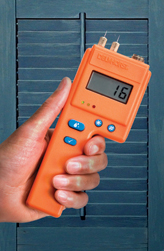Getting Accurate Moisture Content Readings in Wood

Experienced professionals who work with wood as a material for flooring, furniture, and structures know all too well the consequences of the presence of too much moisture. When wood has too much moisture, results include:
-
Buckling, warping, and cupping in flooring.
-
Mold growth.
-
Structural failure of manufactured wood products.
-
Attraction of insects and other undesirable pests.
Because of the potential damage that excess moisture in building materials such as wood can cause, professionals in industries that frequently use wood materials test their lumber products’ moisture content with a variety of pin and pinless moisture meters for wood.
As a means of checking for moisture in wood, moisture meters are the “go-to” tool for finding hidden pockets of moisture that the human eye simply cannot see. These tools, when properly calibrated for the wood they’re being used on, provide a quantifiable reading of the moisture content of wood so that contractors and other professionals can make informed decisions regarding their work.
When professionals use moisture meters to read the moisture content of wood (as well as other building materials), they need to be able to rely on their moisture meter to give them a reliable, accurate reading. If a moisture meter’s readings are off, then the professional using the meter will be forced to make decisions based on bad data.
The question here is, “how can professionals make sure that they’re getting accurate readings in wood?”
Ensuring Accuracy in Moisture Meters for Wood: Testing
Whether you use pin or pinless moisture meters (or both) for measuring %MC in wood, regularly checking the accuracy of your moisture meters is a must.
 For pin-type moisture meters, you can often check the accuracy of the meter using a moisture content standard (MCS). An MCS provides a pin-type meter a metal contact surface for users to press the pins of the moisture meter against to create a closed circuit where there is a set resistance value.
For pin-type moisture meters, you can often check the accuracy of the meter using a moisture content standard (MCS). An MCS provides a pin-type meter a metal contact surface for users to press the pins of the moisture meter against to create a closed circuit where there is a set resistance value.
If your moisture meter returns a reading other than the value the MCS is designed to give, then you’ll know that it is out of calibration and needs to be fixed. Note that with an MCS, the device is usually created specifically for a given model of moisture meter.
For pinless meters, a sensor block is a common testing device. When scanned with a pinless moisture meter, these blocks are supposed to return a specific %MC reading. Just like with an MCS, a sensor block is typically created for a specific model of moisture meter to produce the most consistent results.
To get the best results, make sure that your sensor block is kept in its packaging when not in use and stored according to the directions on the package.
For certain models of moisture meters, there is another way to check the accuracy of the meter: a built-in calibration check. When a moisture meter has this handy feature, you can check the meter’s accuracy in the field without having to use any external equipment. It’s almost like having a moisture content standard built right into the meter itself. Combining these built-in calibration checks with external checks such as a sensor block or MCS is a great way to verify that a moisture meter is accurate.
Ensuring Accuracy in Moisture Meters for Wood: Species Corrections
One of the leading causes of inaccurate readings in wood is that the moisture meter is being used for a species of wood that it was not calibrated for. Typically, a moisture meter is calibrated to get readings in one type of wood such as Douglas fir. If used to scan a different type of wood such as oak, the meter would give a different reading, even if the actual %MC of that oak was the same as the %MC of the Douglas fir.
If you’re using a moisture meter that is calibrated to scan one type of wood for a different type, then the reading will not be accurate. However, there is a way to adjust for this difference in wood species by using the meter manufacturer’s wood species correction chart for that moisture meter. These charts tell you how to calculate the actual %MC of wood from the reading given in a variety of common wood species used in the manufacturing industry.
On the other hand, there are moisture meters with a built-in species correction capability that can make the adjustments for you. With these meters, you simply select a species of wood from the list for pin-type meters, or a specific gravity (SG) setting for pinless meters. Once set, the moisture meter will make the reading adjustments for you, giving you an accurate, reliable reading in many different species of wood.
By making species corrections, or by using a moisture meter with the corrections built-in, you can get an accurate reading of the moisture content of wood quickly and easily.
To learn more about how you can get accurate readings from your moisture meters, check out our guide to measuring moisture in flooring today!
Subscribe to Our Blog
Post Related

4 Tips for Picking the Right Moisture Meter Electrode for the Job


